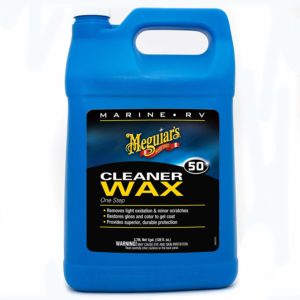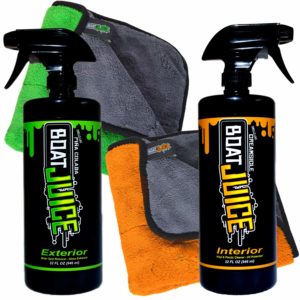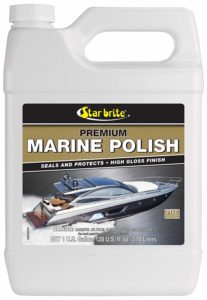 Waxing a car is one thing. It’s quite obvious why a car would need waxing. It’s even understandable why would an owner of a metal boat would want to wax the hull. But what about fiberglass boats?
Waxing a car is one thing. It’s quite obvious why a car would need waxing. It’s even understandable why would an owner of a metal boat would want to wax the hull. But what about fiberglass boats?
Many people think that fiberglass will not rust. They are not wrong, but only because what happens to fiberglass boats is not called rusting. While rust is not a thing for fiberglass, claiming that non-metals don’t corrode is incorrect. Fiberglass boats are normally coated in gelcoat, which is perfectly capable of oxidation, and that, dear sirs and ladies, is called corrosion. Yes, the gelcoat won’t grow rusty because it is not made from metal, but oxidation is not a phenomenon unique to metals.





Top 5 Best Waxes for Fiberglass Boats in 2019
Oxidation is a bad thing for any material, no matter which one I’m talking about. What’s worse, the problem of oxidation is far from uncommon for boats. Even the coat of a brand new boat is already oxidized to a degree. The coat of a boat you’re actively using is going to oxidize completely in a matter of weeks! Just run your hand along the port board, and if it’s covered in a white powder, I have bad news for you.
Oxidation is not the only concern, however. You also have to worry about grime and filth.
“But wait! How is that possible? Boats sit in water, so they are effectively being washed even as they move, right?” Well, the only thing I can say to that is that the cleaning properties of seawater are greatly overrated. A boat won’t accumulate grime and filth as fast as a vehicle that is not in uninterrupted contact with water, but it won’t stay clean forever. Also, the seawater is the last thing to protect your boat from salt, and it only impedes harmful UV radiation if it’s deep enough.
Now, there is no reason to panic. The gelcoat protects your boat from the elements, so the boat is safe even as the protective layer corrodes away. The boat’s looks, however, are pretty much ruined if you don’t do something about that, and quickly at that.
That was the bad news. The good news is you can stop that problem from ever arising if you maintain your fiberglass boat properly. You need three things for that: wet sanding and buffing, polishing, and, finally, waxing. The first two stages are required to prepare your boat for the last stage.
I may cover sanding and finishing in other posts, but for now, let’s focus on waxing.
The most hassle free way to do that is to hire a professional marine detailer to do that for you. But the words “hassle-free” do not imply “low price”, definitely not when it comes to hiring other people for their qualification and talent.
The more preferable way is to do everything yourself. After all, if you’re willing to invest some of your time in research, you can save yourself some money. Isn’t that great?
But with the help of my review, money is not the only thing you’re saving. You’re also saving your time because I’ve made this research for you so you don’t have to. I’ve picked 5 best waxes for fiberglass boats. With them, you can forget about oxidation and dull surfaces for a long time.
1Collinite Fiberglass Boat Wax — Ideal for Fiberglass Boats
In my opinion, Collinite is the number one wax for boats. If you just glance through any boat enthusiast blogs or forums, you’re more than likely to find a mention of Collinite. It is one of the best waxes for boats, and this particular Collinite product is made for fiberglass boats.
Collinite is capable of protecting your boat all year long. It is a liquid formula, and it will shield your boat from salt, sun, detergents, and scuffing during all 12 months.
It possesses antifouling properties, and that means not just better aesthetics but also more speed. Biological fouling is a real problem for many boats and ships that sail for a long time, but with Collinite, marine life taking a liking to your boat is not a problem any longer.
You will get 16 oz. of the product, which is not as generous as what some other brands can offer, but it will cost you less.
- Antifouling properties. Forget about seaweed growing on the hull.
- Year-long protection.
- Lustrous
- More speed
- 16 oz of the product, which is not as generous as what some other brands can offer
2Meguiar's One Step Cleaner Wax — Cleaner-Polisher-Wax Combo
If you want a multi-purpose wax that you can use both on your boat and your RV, then Meguiar’s One Step Cleaner Wax is just the thing for you. A shiny glossy boat and an RV that is just as glassy, is there anything more gorgeous?
Meguiar’s offers more than just wax. Marine and auto detailers are quite familiar with their other products, such as Marine Detailer, but this wax is also an outstanding product.
Its most fascinating feature is that it allows you to get your boat all polished and sparkling in just one step, just as the name suggests. It will remove oxidation, minor defects and restore colors and brilliance just like that, with several runs with a power buffer or just a few hours of elbow grease. It doubles as a polisher, but it’s also great as wax. Its protective effect is as good as you would expect from any other premium wax. Forget about UV and salt water corrosive effect for at least a few months.
You can save your time on all of the prep steps. This cleaner wax is completely non-abrasive and therefore save for fiberglass and gelcoat. That doesn’t stop if from removing defects and restoring the shine. You get a whole 1 gallon container, which is enough for a large boat — or lasting a smaller boat for a few seasons.
You can get a smaller container if you want, but in my opinion, the One Step Cleaner Wax is best for bigger boats. It can still be used for smaller boats.
Its main advantage is that it does not require any preparation, as it has all the components needed to lay it without polishing the boat first. But I must warn you that you may find the required amount of the wax unusually high, as it doesn’t just coat the surface but also polishes it.
- Does not require any preparation. You can just use it right away
- Multi-purpose wax. You can use it both on your boat and your RV
- One step. All it takes to get your boat all polished and sparkling
- Restoration. Removes oxidation, minor defects and restores colors
- Doubles as a polisher. Enough said.
- Protective effect on par premium waxes
- Non-abrasive. Since it’s not cutting, it does not damage the surface, however slightly
- High consumption rate. It doesn't just coat the surface but also polishes it
3Boat Bling Hard Water Spot Remover — Perfect for Patching Waxless Spots
Wax does not protect you from everything. It still leaves the surface suitable for hard water spots and salt deposits to form, as it is a suitable surface for soot to settle on. It’s not impossible to remove that, but that’s where another problem that comes into play: the wax layer either comes off entirely or is damaged enough that your boat will require re-waxing. And that’s something none of us likes.
All too often remove your current wax layer is a required step to get rid of hard water spots and other spots, and then you have to add a new protection layer.
Hard Water Spot Remover from Boat Bling does not work like that. First, it does not remove the wax when removing any foul. Second, it contains wax sealants, and that means it reinforces the wax layer. And it’s not toxic, unlike many detergents used to remove water hard spots, in fact, it’s biodegradable.
All you have to do it to spray it on the surface, wipe it off, and you’re done. The soot or hard water spot is not gone, and the wax layer is even stronger now.
As you can guess, it’s completely unsuitable for waxing a whole boat anew, even a small one. This Hard Water Spot Remover is an ideal tool to handle foul and patch spots where the wax has come off. It’s not a wax, but it works great in tandem with wax.
- Reinforces the wax layer and covers spots
- Non-toxic. A necessity for marine waxes
- Biodegradable. A step above non-toxic
- Ideal tool to handle foul and patch spots where the wax has come off
- Entirely unsuitable for waxing a whole boat anew, even a small one
4Boat Juice Cleaner Bundle Pack — Multiple Purposes Wax
If polishing your girl is not the only makeup job you want to do, if you are going to work on her interior as well, then how about getting a whole bundle? For a very moderate price, you get Boat Juice Interior and Boat Juice Exterior, coupled with appropriate towels.
But that is beside the point. For now, let’s talk about what the Exterior wax can offer you.
For s
tarters, that’s a polymer synthetic wax. It can be applied on your boat’s hull regardless of whether it’s dry or wet, and it’s going to protect your boat just as good as any other wax, ensuring shiny and glossy appeal.
It is also a good cleaner, and it removes any mineral deposits as you wax the surface. And, unlike many other cleaners and waxes, this Boat Juice Wax has a nice and pleasant scent, rather than a heavy vinegar-like chemical odor.
You can use this wax for than just waxing your boat. You can wax your bike or car, you can wax your RV or even kitchen appliances. It’s that good and nice-smelling.
Just spray and wipe it off, and you’re done.
It is fantastic for patching waxless spots. It is going to become one of your favorite waxes for your boat. That said, it’s still not a dedicated wax.
- Polymer synthetic wax
- Wet application. Can be applied on your boat’s hull regardless of whether it’s dry or wet
- Capable of cleaning
- Removes any mineral deposits
- Pleasant scent
- Fantastic for patching waxless spots
- Not a dedicated wax
5Star Brite Premium Marine Polish — Best Wax to Apply Over Existing Layer
If you want to apply a new wax layer, you often need the old layer to go. Not with this Marine Polish, though. It is made specifically to be applicable over an old layer of wax or polish. And it’s not the only advantage it has to offer.
The Star Brite Marine Polish is capable of removing slight oxidation, and its UV protection lasts up to 5 times longer compared to other protective waxes. It is exceptionally sleek, not just in the way it looks but also to the touch, and that makes a boat slightly faster thanks to the reduction of friction.
All in all, this wax is great for fiberglass boats covered with gelcoat, as it is capable of removing oxidation by itself, you won’t have to wet sand the hull unless you’re dealing with a particularly nasty case of oxidation. Alas, it can’t really fight a serious case of oxidation. Still, if you’re not a fan of sanding, this wax is for you.
- Explicitly made to be applicable over an old coat of wax or polish
- Capable of removing slight oxidation
- UV protection lasts up to 5 times longer compared to other protective waxes
- Exceptionally sleek
- Excellent for fiberglass boats covered with gelcoat
- Useless agasint severe cases of oxidation
Buyer’s Guide
Container Size
Waxes come in different containers. 16-18 oz. is the typical volume, 1-gallon containers are also quite popular.If my experience, if you don’t overapply the wax, a 16 oz. bottle is enough for coating the hull of a typical 32 ft. boat. If you do over apply the wax, it’s going to streak like no one’s business, and its consumption is going to skyrocket exponentially. Don’t worry, you’re going to learn to save it real quick, but if you don’t have any experience waxing boats, it would be a good idea to buy a spare bottle.Wax vs. Sealant
Strictly speaking, boat wax is a product that is made from natural organic wax. The proper way to refer to a 100% synthetic “wax” is a sealant. However, a multitude of sealants does include natural wax, which makes them hybrid products. If that is the case, calling them either wax or synthetic sealant is not wrong, and a manufacturer can do that whenever they like.So, which one is better? As strange as it sounds, there’s no major difference. But if you are against contributing to water pollution, I suggest that you make sure your wax or sealant is biodegradable.Tips
Steps to Take Before Waxing Your Boat
Depending on the age of your boat, it can be too late to improve her looks with a wax job. An old fiberglass boat is likely to have a very thin gelcoat layer if any, and it’s always growing thinner when your polish or sand it. It’s better to do a paint job if your boat is too old, but you can also use a sealant polish (lay it at least half a dozen times).The rule of thumb is, the worse your boat looks, the less a wax job can help her. Wax is but a final cosmetic sealer. It can make your boat shine and sparkle, but you have to do a lot of preparation procedures for that kind of effect. The most important thing that many people skip is polishing. Even if a wax product is capable of polishing, you still need to do that polishing, even if you use the wax for that.Step 1. Washing
The first thing you have to do is to wash your boat. That way you remove everything that can hinder your progress when you’re doing the other stages.Make sure to use a wax-safe detergent. You don’t want your old wax layer to go if you can help it.Step 2. Sanding
Or, to be more specific, wet-sanding. Dry sanding is still a viable option, however, wet-sanding is just better when dealing with gelcoat.For wet-sanding, just plunge the sand paper into soapy water before rubbing the surface. Make sure to use very fine sandpaper from the very beginning, you want it to be at least 1000 grit. As you progress, replace it with an even finer sandpaper, until you finally get to 1500 grit, or even higher.Step 3. Polishing
After you are done with the sanding, polish the hull, preferably with a power buffer. Not that manual polishing is somehow worse, but it’s going to take a lot of your time.If you want to get a buffed up glassy coat, now is the right time to get it done. You can’t buff up the wax, it’s simply a protectant. Apply polish or a compound that is marked as buffing/polishing capable. Some waxes can be used for polishing, but only hybrid synthetic waxes are capable of that.Step 4. Waxing
It is now time to apply the wax. Don’t use too much, it’s not going to stay there. Also, make sure not to rub it in forcefully, that’s completely unnecessary.Again, you can do the waxing by hand, but I strongly advise that you use some powered tools for that.Step 5. Post Processing
“Post Processing” sounds big. But it just means you have to wait for the wax to dry and wipe it with a clean towel when it’s finally over.Powered Tools vs. Elbow Grease
It’s quite simple: a power buffer will save you a lot of time. On the other hand, manual sanding and waxing allows for precise sanding and applying the polisher and wax.Of course, I recommend going for the powered option, but with a single exception. When you do your hull for the first time, do it by hand. It’s not required, of course, but it should let you study every inch of your boat with your own eyes.Questions and Answers
Although the wax protects your boat from sun, rain, and seawater, nothing protects the wax from them. That’s fine, you can always apply the wax again when it comes off.
But you can also wash it off accidentally. Only use detergents that are marked as safe for wax. Do not use degreaser soap under any circumstances, unless you intend to remove the wax layer.
It depends on the wax, the boat and the sailing condition. On average, however, you should expect a need for a re-waxing arise no sooner than in 9 months.
Yes, you can do that. Moreover, it’s going to be perfectly safe for your boat as long as that car wax contains no abrasive. But the effectiveness of such a measure would be quite questionable.
Marine waxes are designed to protect the hull from UV radiation and salt, as well as oxidation, and a car wax may come off very soon. It’s not designed to persist in that kind of stress. Gelcoat is porous, quite unlike anything a car coat is. That renders any car wax ineffective for applying on a fiberglass boat.
